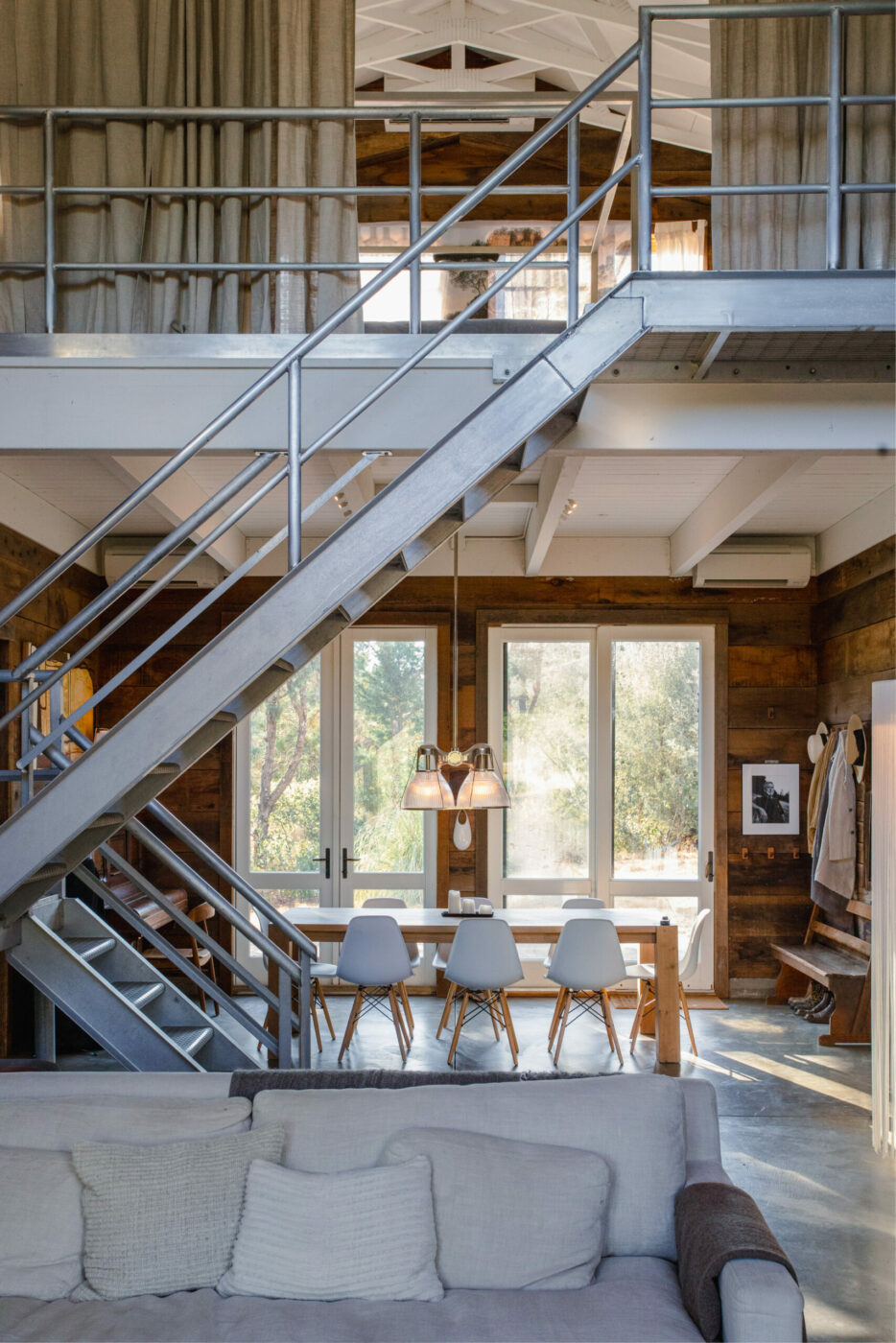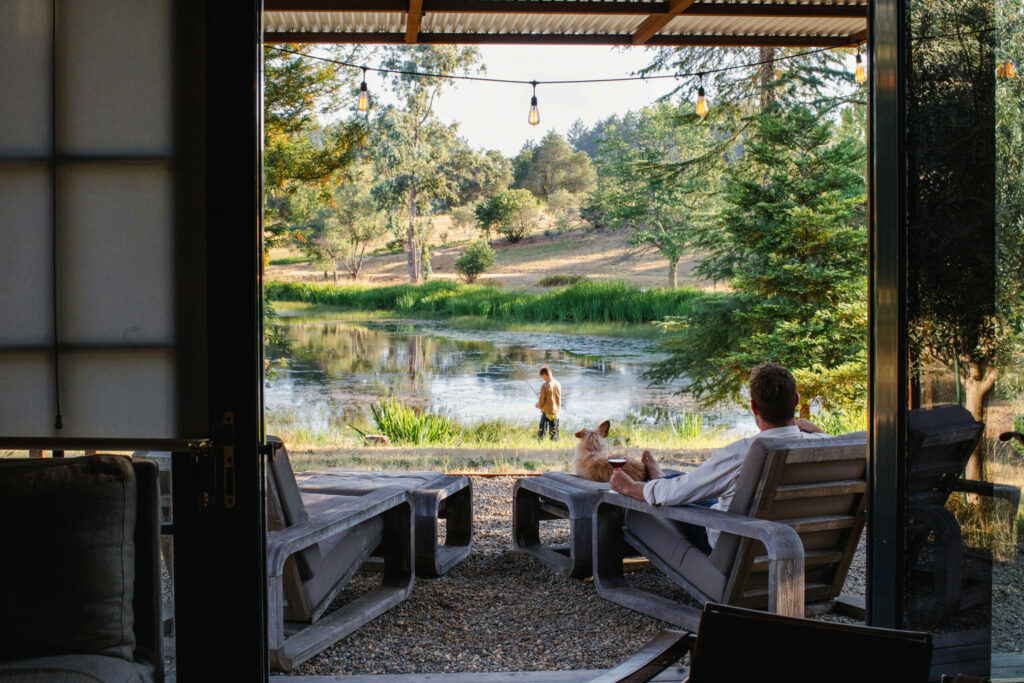A deep-rooted connection to the landscape marks the rustic home of architectural designer Lisa Steinkamp and winemaker Scot Bilbro. On 5 rural acres in Healdsburg (“but just two minutes from Big John’s Market,” Lisa says), the couple and their son live in a simple, barnlike structure with broad connections to the outdoors from nearly every room.
“The thing we’ve always loved about this property is no matter where you are on it, whichever structure you’re in, you’re just looking at more wilderness,” says Scot. “It feels like you’re on a much, much bigger property than you are.”
The couple, who met in the early 2000s, were living in downtown Healdsburg in 2013 and had been looking for rural land for several years when Lisa got a tip from an old friend that the property was for sale. Though the outbuildings were in rough condition and overgrown with brambles, they could see the contours of the land held a beautiful shape, overlooking a sweeping view of a pond populated with herons, turtles and other wildlife.
“I was just itching to be able to walk out onto some meadow, to have some larger confines around us,” says Scot.

He and Lisa designed the home together and undertook much of the construction themselves. They endlessly discussed the framing of the view through the antique windows they’d found, accumulating repurposed doors and redwood siding — even teaching themselves how to use SketchUp to draw their plans. Lisa envisioned a classic California indoor-outdoor home with pocket gardens and living spaces that blurred the distinction between inside and out.
“The thought process was to create a very small envelope of curated space around the house,” she explains. “It’s very clean, intentional. It was important not to have an immaculate garden space, but to feel like we were living in nature.”
Downstairs is one large room with separate spaces for living, dining, lounging and cooking. There’s a single bathroom that the entire family uses, and a bedroom for their son, as well as multiple sets of doors with views out to the pond and fields.
Scot and Lisa’s room is upstairs, reached via a set of stainless-steel scaffolding Scot repurposed from his winery. They’re the type of stairs more commonly used to access the tops of wine tanks during fermentation.

The interior, including 25-foot-tall walls in the main living space, is clad entirely in gorgeous, inch-thick, foot-wide reclaimed redwood boards.
“We were almost finished, and Scot kept saying, ‘Hey, why don’t you sheetrock the walls,’” recalls Lisa. “And I said ‘I can’t. I can’t do it.’ I didn’t know what I was waiting for. But then I got a call from our wood guy, who had found some secret stash of barnwood sitting under a tarp somewhere. So I jumped in his truck and we got the wood, and that clad the entire space.”
Though built less than a decade ago, this is a storied home, one layered with a history and personality that reveal much about the family that built it. The living areas have wide comfy couches and lots of pillows for reading and nesting. Lisa is drawn to pieces with a background: a chandelier draped in fringe, opera costumes purchased for a song at a sample sale, handmade ceramics, an antique upright piano.
“The place is from the heart,” says Lisa. “It’s cozy — which is weird to say with 25-foot ceilings, you know.”

Their design decisions have been guided by a feeling of what is right for the home and the property, even if their choices seem unconventional or unusual.
“Our signal that we’re doing the right thing is whenever somebody says, ‘Why are you doing this?’ or ‘What do you see in this property?’” says Scot. “Basically, whenever someone tells us we’re crazy, we’re like, ‘Oh, we’re on the right track.’ Usually Lisa and I are totally in sync in terms of feeling there’s potential and magic in a place. And it’s all the better when nobody else can see it.”
The couple are proud to be passing along their creative values to their son, Booker,
who was just a toddler when they first moved to the property and is now 13 years old.
“We are doing a really good job of training our kid that used is good,” says Lisa. “In a world where fashion is in constant turnaround and quality has gone down and mountains of throwaway clothing are sent far across the ocean, he’s learning all that’s not necessary.”
Booker, who wants to be a pilot, spends his summers outside fishing for bass on the pond or tinkering with motorcycles and model airplanes. With a cheeky high-schooler’s sense of humor, he names all of the goslings on the pond Ryan. There’s a whole bevy of Ryan Goslings hatched each spring.

“Booker’s exposure to all this has gotten us to the point where he’s the one who reminds us how to play outside. He gets us out on the lake, out on the paddleboard,” says Scot.
The family lives in tune with the seasons, throwing the doors wide open
each morning and eating outdoors on the patio most nights. Scot likes to grill whole fish or lamb, while Booker rolls out pasta from scratch. The three of them make big salads with produce grown in raised beds made from half-ton bins from the winery.
“Being in the wine industry, having every seasonal change mean something’s happening is really fun,” says Scot. “It makes you feel connected to your job and what’s going on and where you live in a different way.”
“I work really hard to be present. When you’re working in agriculture, you’re always looking ahead. There’s a similarity between working on projects at the house and growing grapes and making wine. You’re in the midst of a perpetual transformation — you’re watching the leaves come out, you’re watching the canopies. Suddenly there’s fruit, and suddenly again, it changes color, and then you’re in the cellar. I just think it’s an amazing process… It’s like one big choose-your-own-adventure story.”





















